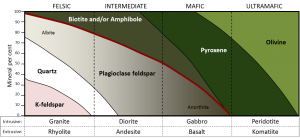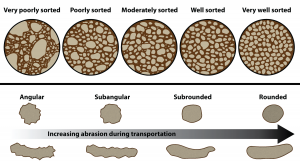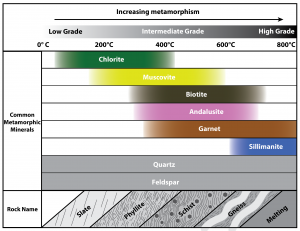Rock Classification Tables
Igneous Rocks


Sedimentary Rocks
| Type | Description | Size range (millimetres, mm) | Size range (microns, μm) |
|---|---|---|---|
| Boulder | large | 1024 and up | |
| medium | 512 to 1024 | ||
| small | 256 to 512 | ||
| Cobble | large | 128 to 256 | |
| small | 64 to 128 | ||
| Pebble (Granule) | very coarse | 32 to 64 | |
| coarse | 16 to 32 | ||
| medium | 8 to 16 | ||
| fine | 4 to 8 | ||
| very fine | 2 to 4 | ||
| Sand | very coarse | 1 to 2 | 1000 to 2000 |
| coarse | 0.5 to 1 | 500 to 1000 | |
| medium | 0.25 to 0.5 (1/4 to 1/2 mm) | 250 to 500 | |
| fine | 0.125 to 0.25 (1/8 to 1/4 mm) | 125 to 250 | |
| very fine | 0.063 to 0.125 (1/16 to 1/8 mm) | 63 to 125 | |
| Silt | very coarse | 32 to 63 | |
| course | 16 to 32 | ||
| medium | 8 to 16 | ||
| fine | 4 to 8 | ||
| very fine | 2 to 4 | ||
| Clay | clay | 0 to 2 |
| Group | Examples | Characteristics |
|---|---|---|
| Conglomerate | Dominated by rounded clasts, granule size and larger (>2 mm), poorly to very poorly sorted | |
| Breccia | Dominated by angular clasts, granule size and larger (>2 mm), poorly to very poorly sorted | |
| Sandstone | quartz sandstone | Dominated by sand (1/16 to 2 mm), greater than 90% quartz, range of roundness and sorting possible |
| arkose (feldspathic sandstone) | Dominated by sand (1/16 to 2 mm), greater than 10% feldspar, range of roundness and sorting possible | |
| lithic wacke | Dominated by sand (1/16 to 2 mm), greater than 10% rock fragments, greater than 15% silt and clay, range of roundness and sorting possible | |
| Mudrock | mudstone | Greater than 75% silt (1/256 to 1/16 mm) and clay (<1/256 mm), not bedded, well-sorted, grains too fine to judge roundness using hand lens |
| shale | Greater than 75% silt (1/256 to 1/16 mm) and clay (<1/256 mm), thinly bedded, well-sorted, grains too fine to judge roundness using hand lens |


| Composition | Texture | Distinctive Properties | Rock Name |
| Calcite (CaCO3)
*Note that all limestones will react with dilute HCl. |
Crystalline | Crystalline; fine to coarse grained | Crystalline limestone |
| Fossiliferous | Various fossil fragments well cemented together | Fossiliferous limestone | |
| Oolitic | Comprised of ooids (spheroidal particles typically <2 mm in diameter) | Oolitic limestone | |
| Bioclastic | Visible shell fragments weakly cemented together | Coquina | |
| Bioclastic | Soft rock made of microscopic shells | Chalk | |
| Quartz (SiO2) | Microcrystalline | Microcrystalline; hardness of ~7 (can scratch glass); may exhibit conchoidal fracture | Chert (note that dark coloured varieties may be called flint and red coloured varieties may be called jasper) |
| Halite (NaCl) | Crystalline | Crystalline; fine to coarse grained; commonly forms cubic crystals; tastes salty | Rock salt |
| Gypsum (CaSO4·H2O) | Crystalline | Crystalline; fine to coarse grained; hardness ~2 (can scratch with fingernail) | Rock gypsum |
| Organic material (plant fragments) | Amorphous | Black brittle rock with amorphous texture; low density | Coal |
Metamorphic Rocks

| Protolith | Very Low Grade (150-300°C) | Low Grade (300-450°C) | Medium Grade (450-550°C) | High Grade (Above 550°C) |
|---|---|---|---|---|
| Mudrock | slate | phyllite | schist | gneiss |
| Granite | no change | no change | almost no change | granite gneiss |
| Basalt | greenschist | greenschist | amphibolite | amphibolite |
| Sandstone | no change | little change | quartzite | quartzite |
| Limestone | little change | marble | marble | marble |
Media Attributions
- Figures A, B, D: © Steven Earle. CC BY.
- Figures C, E: © Siobhan McGoldrick. CC BY.

